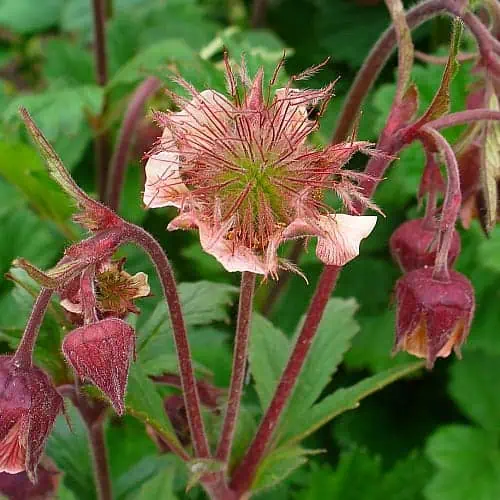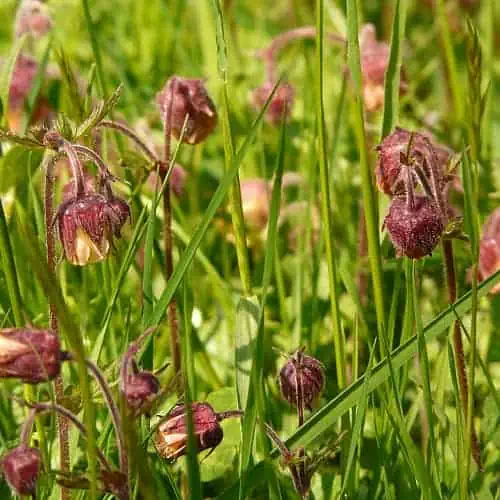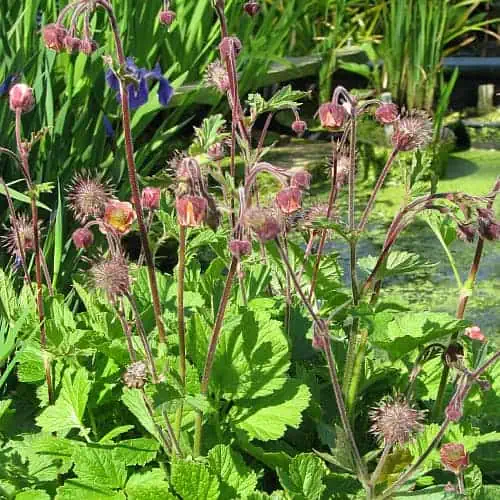
Geum rivale is commonly known by several names, including nodding avens, drooping avens, cure-all, purple avens, Indian chocolate, and water flower. This flowering perennial herb is in the family Rosaceae. As its name suggests, this plant is a fan of damp and wet soils. Water avens is native to large portions of Europe, Central Asia, and North America. This plant produces downward facing (or “nodding”) bell-shaped flowers from spring to late summer.
Water avens’ flowers are unique and provide an excellent contrast to many other wetland plants found in and near ponds. Interestingly, the calyx, the part of the stem that is attached to the flower, is the same color as the blooms themselves! Even the seed pods left behind after the flowers bloom have an interesting, feathery appearance. Flower color can change depending on specific variety of the plant, and water avens can even hybridize with the closely related plant wood avens (Geum urbanum).
Facts, Benefits & Uses of Water Avens

Water avens can greatly contribute to a garden ecosystem, as they attract pollinators such as dragonflies, butterflies, moths, and bees. Since they bloom later into the year, they also provide extra benefit to pollinators during this time. Amphibians such as frogs and newts often use water avens for shade and protection. If you want to encourage local pollinators and frogs to enjoy your pond, this species can be an excellent option.
An added benefit is that water avens is deer resistant. This plant is a component of purple moor grass and rush pastures, which are protected in the United Kingdom.
Water avens has been used throughout history as a medicinal plant. Due to its high levels of astringency, this plant has typically been used to help with digestive issues. To this day, some people use water avens as an anti-inflammatory, fever-reducer, and digestive aid, although these uses have not been well studied.
Water Avens Growth, Hardiness & Climate

Water avens grows fairly quickly and is generally considered to be low maintenance. However, it is drought intolerant, and must have consistent access to plenty of water. In the wild, water avens can be found growing in damp meadows, as well as along the margins of ponds and streams.
Overall, water avens grows easily without intervention. This plant does best in a wetland environment, or on the margins of a pond. Water avens is a perennial and can survive winters in USDA hardiness zones 3-7. This plant’s interesting blooms are a beautiful ornamental addition to gardens and blooming typically occurs from May through September. This long blooming period is one of the reasons that water avens can be a good choice for a home pond or water garden.
How to Plant Water Avens In Ponds

In general, water avens seeds are dependent on cold stratification in order to grow, meaning that they require a period of cold weather in order to emerge from dormancy. Gently press seeds just under the surface of the soil in autumn. There is no need to water the seeds yet, as they will not germinate until spring arrives. However, be sure to keep the soil moist once your seeds sprout. Alternatively, you can sow seeds in seed trays outside, and plant the plugs in the soil in Spring.
If growing water avens from an already established plant, simply bury the roots up to the crown of the stem in rich soil. This plant does best in moist, well-drained soils.
How to Care For Water Avens

Water avens does best when exposed to partial sun, although it is somewhat shade tolerant. The most important factor in caring for water avens is ensuring that it has access to plenty of water. Planting water avens near the margins of your pond is a great way to make sure it has access to thoroughly damp soil year-round.
How to Winter Water Avens
Water avens is native to northern areas with cold winters, such as North-eastern America, and as a result is able to survive cold weather without much difficulty. In fact, it is important that this plant is grown in areas with cold winters because its seeds rely on cold stratification to sprout in the spring. There is no need for any special treatment to prepare water avens for winter when grown in its native hardiness zones.
If growing outside of its native hardiness zones, please consider whether this plant could be potentially invasive in your area. You can simulate winter conditions for it by placing seeds in a fridge, freezer, or other cold environment for the winter.
Is Water Avens Toxic, Poisonous or Invasive?
Water avens can technically be invasive outside its native areas, but in general it is not considered to be an aggressively spreading plant. If you are set on growing water avens in your pond or garden but are concerned about spread, you can remove flower heads before they go to seed. It is also a good idea to thin plants out every few years to avoid overcrowding.
Water avens is not considered to be toxic, and in fact has a long history of being consumed by humans for a variety of reasons.
Is Water Avens Edible? Will Fish Eat it?
Water avens is edible and is known to be a folk remedy for various medical issues. Although this plant is technically edible, it is high in tannins and as such is not necessarily very palatable. However, there is one exception: when boiled in water, the roots produce a liquid that is said to taste like chocolate! Powdered water avens roots used to be used as a cocoa substitute for this reason.
Pond fish will likely not get the chance to eat water avens, as it is not a fully aquatic plant, but they should not experience any ill effects if they do try to eat any fallen flowers, seeds, or leaves that happen to get into the water.
Where to Buy Water Avens & Seeds? (UK & US)
Water avens is easily obtained from plant nurseries in its native ranges in Europe, Asia, and North America, both in person and online. Elsewhere, you may have to order it online if you are set on having it in your garden. As always, try to plant native species in your pond or garden whenever possible.


I have naturalized water Avens growing voluntarily in a boggy section of our property. What can I do to encourage their growth?
I am a gardener with a large pond 4 x10 metres which was overgrown and is now cleared.can you suggest a nursery where I can buy. I am looking at plants in pots to put around the damp edges later this month. Thought your article was very informative thank you
Can you recommend a nursery where I can buy please